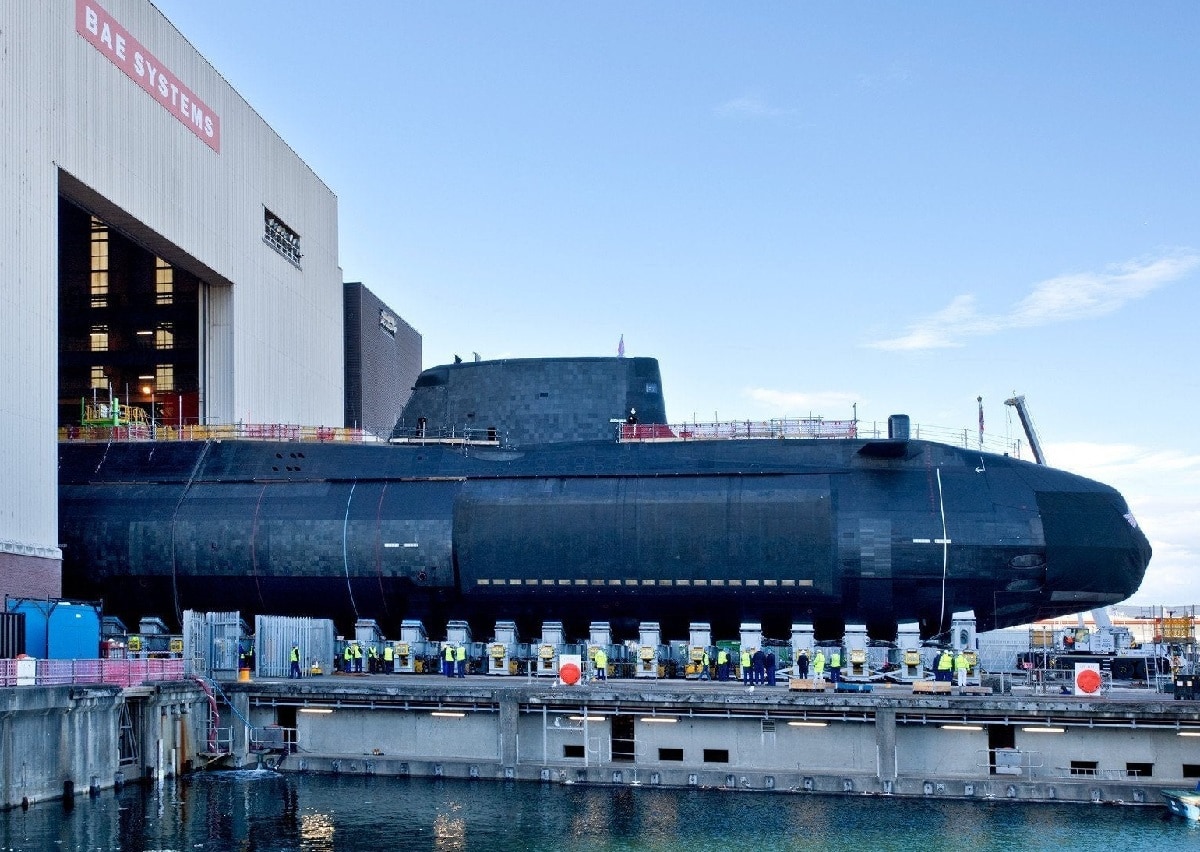Published on 2/10/2023: Meet the Astute-Class Submarine – Merriam-Webster’s Dictionary defines the word “astute” as “having or showing shrewdness and an ability to notice and understand things clearly: mentally sharp or clever.” In other words, mentally gifted, but not necessarily physically powerful or intimidating, as there’s no mention of brawn to go with the brains.
Nonetheless, the powers that be with regard to Britain’s Royal Navy warship naming conventions saw fit to apply the name to their newest class of currently operational submarines.
Say hello to the Astute-class nuclear-powered fleet submarines (SSNs).
Astute-Class: Origins and Specifications
The Astute boats’ are the successors to the Trafalgar-class “hunter-killer” subs (admittedly that name sounds more “martial,” for lack of a better word), which had entered into service in 1983, with only one, HMS Triumph (S93), remaining in service.
The first ship of the Astute class to go operational – dubbed HMS Astute (S119) appropriately enough – was launched by then-Duchess Camilla – now the Queen Consort — in 2007.
That sub was commissioned in August 2010, followed by the Ambush (S120) (okay, now that one does sound more pugilistic), Artful (S121) and Audacious (S122) in March 2013, March 2016, and September 2021 respectively; meanwhile, HMS Anson (S123) was commissioned in August 2022 but hasn’t yet attained full operational status, whilst Agamemnon (S124) and Agincourt (S125) are under construction, expected to be commissioned sometime in 2024 and 2026 respectively.
Construction is being carried out by BAE Systems Submarines at the port town Barrow-in-Furness in Cumbria, England.
The Astutes carry a crew complement of 98 commissioned officers and enlisted sailors.
They sport a hull length of 318 feet and 3 inches, a beam width of 37 feet and 1 inch, a draft of 32 feet and 10 inches, a surface displacement of 7,400 tons, and a submerged displacement of 7,800 tons, Submerged speed is 30 knots (35 miles per hour).
Test depth is in excess of 980 feet.
Armament starts off with six 21-inch 533mm torpedo tubes with a maximum stowage capacity of 38 Spearfish Mod-1 heavyweight torpedoes, which pack a fearsome punch in the guise of a 660-pound warhead and can reach targets out to 29 nautical miles and traverse the water at a speed of 80 knots; as Navy Lookout (which describes itself as “Independent Royal Navy news and analysis”) puts it, “Spearfish Mod-1 is probably now one the best heavyweight torpedos [sic] in service anywhere in the world and represents the culmination of a large effort across UK industry, DE&S [Defense Equipment & Support] and the navy. It provides the RN with a lethal ship and submarine killer able to resist modern decoys and countermeasures.”
For good measure, these warships also wield the latest version of the Tomahawk Land Attack Cruise Missile (TLAM), the Tomahawk IV, which has a 1,000-lb. high explosive warhead and a range of over 1,000 miles.
Real-World Performance
As per the official Royal Navy info page: “The Astute-class submarines are the largest, most advanced and most powerful attack submarines ever operated by the Royal Navy, combining world-leading sensors, design and weaponry in a versatile vessel…In the first part of 2012, they proved their ability to prepare and launch Tomahawk missiles, successfully firing 2 missiles from the Gulf of Mexico and accurately hitting the targets on the test range in Northern Florida.”
This past June, Audacious carried out NATO security patrols in the Mediterranean on her maiden operational deployment, which presumably took on an additional sense of urgency in light of Putin’s “special military operation” in Ukraine.
As far as I can ascertain, none of the Astutes have been used in actual combat operations yet, whether against land targets or warships alike. (As some of our dear readers may recall, the last sinking of an enemy warship by a submarine took place back in May 1982 during the Falklands War — “La Guerra de Las Malvinas” as the Argentines call it — when the Churchill-class attack submarine HMS Conqueror sank the Argentina Navy cruiser ARA General Belgrano.)
The Astute-class would be a major threat to the Russian Navy in the event of some sort of crisis.
The Future: Aspiring Aussie Astutes?
As impressive as the Astute-class subs are, the Royal Navy’s submarine force and its associated industries aren’t resting on their laurels, as BAE is already hard at work at the next generation of ballistic missile submarines (SSBNs), that being the Dreadnought-class boats. However, these are actually being built as replacement for the Vanguard-class SSBNs.
Meanwhile, the future of the Astute class looks bright. Besides their ongoing use by Britain’s Royal Navy, there’s a strong possibility that they’ll soon find a new Commonwealth customer, namely the Royal Australian Navy (RAN), as part of the AUKUS pact that so thoroughly pissed off France.
More specifically, the Astutes are a prime candidate to eventually replace the RAN’s current Collins-class SSGs, which are currently slated to serve in 2038.
We at 19FortyFive will be sure to keep our dear readers posted on the latest developments in this arena, so stay tuned.
Christian D. Orr is a former Air Force Security Forces officer, Federal law enforcement officer, and private military contractor (with assignments worked in Iraq, the United Arab Emirates, Kosovo, Japan, Germany, and the Pentagon). Chris holds a B.A. in International Relations from the University of Southern California (USC) and an M.A. in Intelligence Studies (concentration in Terrorism Studies) from American Military University (AMU). He has also been published in The Daily Torch and The Journal of Intelligence and Cyber Security. Last but not least, he is a Companion of the Order of the Naval Order of the United States (NOUS). In his spare time, he enjoys shooting, dining out, cigars, Irish and British pubs, travel, USC Trojans college football, and Washington DC professional sports.

